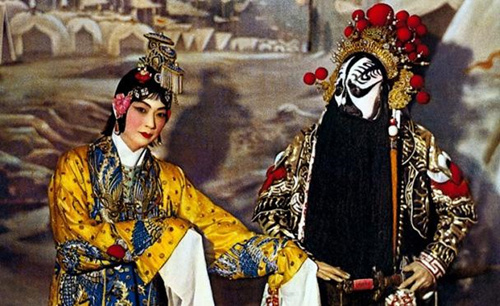
. > WHAT'S NEW > RESEARCH
Comparative study could advance Chinese opera’s modern expression
Author : XIANG JIANGTAO Source : Chinese Social Sciences Today 2018-11-12

A stage photo of Mei Lanfang (Left) in Peking opera Farewell My Concubine. Photo: FILE
From Oct. 22 to 23, the “Oriental and Western—Mei Lanfang, Steiny and Brecht International Symposium” hosted by the China Academy of Art and the Mei Lanfang Memorial Hall was held in Beijing. Scholars focused on the big picture of world drama, discussed the relationship between Mei Lanfang’s opera performance systems and the performance systems of Steiny and Brecht, summed up the rules of development of Chinese opera and explored pathways forward for Chinese opera.
Mei Lanfang (1894-1961) has contributed a lot to facilitating dialogue between Chinese opera and world drama and making Chinese culture “go global.” Han Ziyong, dean of the China Academy of Art, believed that Mei was not only a prominent Peking opera performer in the 20th century but also a Chinese cultural messenger who traveled overseas and earned great prestige around the world. Western theater was greatly affected by Mei’s performances in Moscow in 1935.
Zeng Yongyi, a lecturer at Shih Hsin University in Taiwan, said in his speech that there are “the art of expression” and “the alienation effect” in drama theory. The former is represented by the Soviet Stanislavski and the latter is represented by Brecht, a German poet and playwright.
Sun Huizhu, a professor at the Shanghai Theatre Academy, believed that the characteristics of Mei’s performance system are not only reflected in performance skills and aesthetics—the overall theatrical approach to creation of Mei and his colleagues from the performance right through to the scriptwriting is also worthy of further study. Looking at all aspects of the creation, it can even be said that Mei surpassed Stanislavski and Brecht.
At the beginning of the 20th century, scholars began to interpret Chinese works with Western theories. For example, Western drama theory introduced by Wang Guowei to explain Dream of the Red Chamber and Yuan-Dynasty Zaju opera played a role in promoting Chinese opera studies. Today, when scholars continue to learn from Western theories and methods, they should enhance cultural self-confidence and use Chinese discourse to interpret the aesthetic features of Chinese opera.
Wang Ankui, a research fellow at the China Academy of Art, believed that the distinguishing factor between the two lies in the differences in aesthetic values, so a comparative study is needed. Emphasizing the differences in various drama cultures helps show that different forms of drama have their own paths of development, which cannot be replaced by each other, but should be understood, absorbed and drawn on by each other.
Zhou Huabin, a professor at the Communication University of China, said that in the international theater of the 20th century, Stanislavski and Brecht have made outstanding contributions and their experience is worthy of being absorbed by contemporary Chinese theater. The Chinese opera, represented by Mei’s works, is also worthy of reference by the international drama community. In this new historical period, the dramas of all nationalities and nations are worth learning from. The Chinese opera world should neither be self-important nor underestimated.
Ma Guojun, a professor at the Central Academy of Drama, said that people from other countries obtained a preliminary knowledge of Chinese opera through Mei and his excellent performances, but they failed to develop a comprehensive understanding of Chinese opera. When discussing the differences between the Western drama system and the oriental drama system, we can regard Mei as a symbol of Peking opera and even Chinese opera.
The performance systems of Mei, Stanislavski and Brecht, were not formed independently, but are the result of a combination of different cultural factors and dramatic concepts. Ran Changjian, a professor at the Chinese Opera Academy, believed that ideographic drama and realist drama have contributed to Mei’s and Stanislavski’s systems of performance. In order to carry forward this excellent traditional culture, we must selectively absorb the beneficial elements in Western realist dramas and continuously improve the artistic ability of Chinese opera to express modern life.
(Edited by JIANG HONG)
Ye Shengtao made Chinese fairy tales from a wilderness
Ye Shengtao (1894–1988) created the first collection of fairy tales in the history of Chinese children’s literature...
-
How northern ethnicities integrated into Chinese nation
2023-09-18
-
Mogao caves
2023-09-12
-
Mogao Grottoes as ‘a place of pilgrimage’
2023-09-12
-
Time-honored architectural traditions in China
2023-08-29
-
Disentangling the civilizational evolution of China
2023-08-28
-
AI ethics in science fiction
2023-08-23













 2011-2013 by www.cssn.cn. All Rights Reserved
2011-2013 by www.cssn.cn. All Rights Reserved